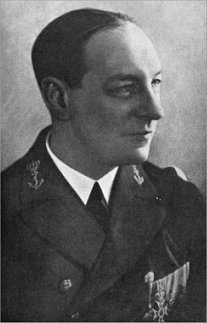Karel Willem Frederik Marie Doorman
Born Utrecht April 23, 1889 - Died on board light cruiser De Ruyter February 28, 1942
 Although Karel Doorman was the son of an army officer, he joined the officer's course at the Naval Institute in 1906, which he completed successfully four years later. After some years in the Netherlands East Indies, he returned to Holland to become one
of the pioneers in Dutch naval aviation. He earned his wings in 1915, and what followed was a turbulent period at the naval
airfield De Kooy until 1921, during which he survived 33 emergency landings. Then, he went to the High Naval Academy to study the art of naval warfare. He was sent out to the NEI for the last time in 1937, where he became the Commanding Officer of the Naval Air Service
during the last prewar years. Being an aviator himself, he understood the value of a well-trained and well-equipped Naval Air Service (the correct
Dutch term is Marine Luchtvaartdienst, or MLD) and under his command, the MLD became just that.
In June 1940, he was given command of the Netherlands East Indies Seagoing Squadron, which normally included the
bulk of the Dutch surface fleet. Although a neglected dysentery started to play up shortly before the start of the Pacific War, he retained
command and was also given command of the Combined Striking Force on February 3, 1942. The idea was to use this
scratch-collection of Dutch, American, British and Australian warships to attack and destroy Japanese invasion convoys. During
the month of February, the force made a number of sorties, which were usually unsuccessful due to Japanese aerial intervention.
It only came to blows during the Battle of Badung Strait, when a numerically superior Allied Force attacked four Japanese destroyers
and a transport, unfortunately without much success. In return, the Japanese managed to sink the destroyer Piet Hein and damage
several other ships.
After this battle, it was clear that the next step would be the invasion of Java island. In compliance with Admiral Helfrich's orders, Doorman
continued to sweep the Java sea with his force, until the Japanese invasion fleet was finally sighted on February 27. Although the two
forces were more or less equal in terms of strength, the Allied were handicapped by the lack of a good communication system, aerial reconnaissance
and rest during the past few months. Both the light cruisers Java and Doorman's flagship, De Ruyter were hit and sunk by torpedoes, taking a heavy
toll among the exhausted crews. It is believed Doorman, his staff and De Ruyter's commanding officer, Commander E.E.B. Lacomblé chose to remain on board as the cruiser sank.
In honor of Admiral Doorman, the only two Dutch aircraft carriers and lastly, a new frigate were named after him. In addition, he was one of only persons who were made Knights in the Military Order of William 3rd class. [1]
| Ranks |
| Midshipman 1st class [2] |
August 24, 1910 |
| Lieutenant |
August 24, 1912 |
| Lieutenant-Commander |
November 1, 1920 |
| Commander |
February 1, 1933 |
| Captain |
September 6, 1937 |
| Rear-Admiral |
May 16, 1940 |
| Postings [3] |
| Coastal defence ship Hr.Ms. Tromp and Hr.Ms. De Ruyter |
1910 |
- |
1913 |
| Light cruiser Hr.Ms. Noord Brabant |
April, 1914 |
- |
1915 |
| Pilot Instructor |
1916 |
- |
1917 |
| Commanding Officer, Naval Airbase De Mok |
August 18, 1917 |
- |
|
| First Officer, Naval Airfield De Kooy |
|
- |
1920 |
| Commanding Officer, Naval Airfield De Kooy |
1920 |
- |
1921 |
| Student Netherlands Naval War College |
November 2, 1921 |
- |
1923 |
| Staff Officer, Ministry of Navy, Weltevreden (Java) |
1923 |
- |
1926 |
| Gunnery Officer, coastal defence ship Hr.Ms. Zeven Provinciën |
May 14, 1926 |
- |
January, 1928 |
| Head MLD Technical Department, The Hague |
March 12, 1928 |
- |
July 14, 1928 |
| First Officer, Naval Airfield De Kooy |
July 14, 1928 |
- |
November 2, 1931 |
| Commanding Officer, minelayer Hr.Ms. Prins van Oranje |
1932 |
- |
1932 |
| Commanding Officer, destroyer Hr.Ms. Witte de With |
1933 |
- |
1933 |
| Commanding Officer, destroyer Hr.Ms. Evertsen and Group Destroyers 1 |
1934 |
- |
1934 |
| Chief of Staff, Den Helder naval base |
June, 1934 |
- |
September 4, 1937 |
| Commanding Officer, light cruiser Hr.Ms. Sumatra |
October 25, 1937 |
- |
June 15, 1938 |
| Commanding Officer, light cruiser Hr.Ms. Java |
June 15, 1938 |
- |
August 13, 1938 |
| Commanding Officer, Naval Air Service NEI |
August 17 1938 |
- |
May 5, 1940 |
| Commanding Officer, NEI Squadron |
June 17, 1940 |
- |
February 27, 1942 |
| Commanding Officer, Combined Striking Force |
February 3, 1942 |
- |
February 27, 1942 |
| Awards |
| Dutch |
Knight in the Military Order of William (MWO.3)
Knight in the Order of the Dutch Lion (NL)
Officer in the Order of Orange Nassau (ON.4)
Service Medal for naval officers, for 30 years' of service (XXX)
Mobilization Cross 1914-1918 (Mk) |
| Foreign |
Silver Cross 5th class, Order Virtuti Militairi (Poland) |
[1]: The other was Captain J.P. van Helsdingen, a fighter pilot of the KNIL airforce. He was killed in action on March 5, 1942.
[2]: The rank of sublieutenant had not yet been introduced at this time.
[3]: For a more thorough, albeit romanticized, description of Doorman's career, the book "Ik val aan, volg mij" by Anthony van Kampen (Published by C.V. Uitgeverij, Amsterdam, 1947), is recommended reading.
|
![]()
![]()

![]()
![]()